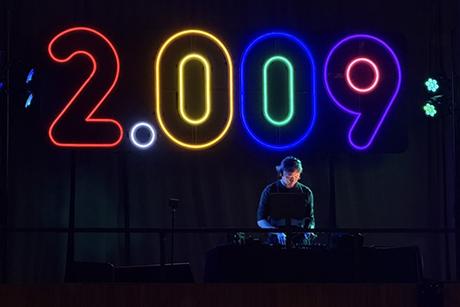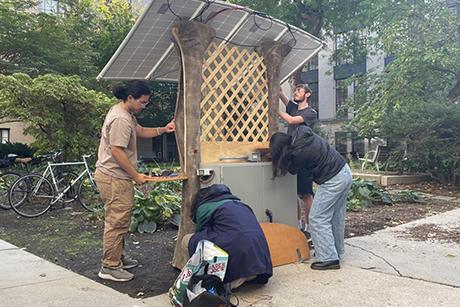A glimpse inside Intel
Intel CEO Pat Gelsinger gave an optimistic account of U.S. semiconductor manufacturing on Friday, telling an MIT audience that the ongoing expansion of his firm’s production capacity would bolster the company over the long term while giving the U.S. more economic and industrial security.
“Everything digital runs on semiconductors,” Gelsinger said. “There is no digital without semiconductors today.”
In 1990, he noted, 80 percent of the world’s semiconductors were built in the U.S. and Europe, whereas today, 80 percent are built in Asia. To spread manufacturing around more evenly, Intel is adding production in two huge fabrication plants, or “fabs,” one in Arizona and one still being built in Ohio.
“We want balanced, resilient supply chains right across the world, and that’s what we’re out to accomplish with the CHIPS Act, and what Intel is driving [at] quite aggressively,” Gelsinger said, speaking before a capacity crowd in MIT’s Wong Auditorium. “Let’s build the fabs where we want them.”
The relative lack of chip manufacturing capacity in the U.S., he added, “became acutely visible as we went through the Covid crisis.”
The “CHIPS and Science” bill signed into law by President Biden last August provides $52 billion in federal funding for research, design, and manufacturing in the U.S. semiconductor industry, and bolsters the National Science Foundation in the process.
“I am confident that we will invent the future,” Gelsinger said. “The question in my mind is: Will we manufacture the future?”
Friday’s event was part of the Manufacturing@MIT Distinguished Speaker Series, which involves campus visits and talks by leaders throughout the manufacturing industries.
Gelsinger was introduced by Anantha P. Chandrakasan, dean of the MIT School of Engineering and the Vannevar Bush Professor of Electrical Engineering and Computer Science. In his remarks, Chandrakasan noted that Gelsinger “is committed to significantly expanding semiconductor manufacturing in the U.S.” and “has strongly supported and driven the CHIPS Act.”
Throughout his comments, Gelsinger emphasized that making semiconductors effectively is an ongoing process, subject to continuous improvement and refinement. At Intel, he said, innovations are most meaningful when applied and used on an everyday basis.
“This is one of the things the founders of Intel deeply believed,” said Gelsinger, who first joined the firm in 1979, stayed there for 30 years, and rejoined as CEO in 2021. “You can’t innovate and not manufacture. Those are inextricable in our industry. And if we’re going to be an innovator at the heart and soul of the digital future, we must be a manufacturer at scale.”
Intel’s ability to scale up its manufacturing is increasing due to a five-year plan Gelsinger is implementing that bolsters the firm’s capital investments — “A $20 billion fab is an extraordinary statement,” he said — with the idea that greater capacity will pay off for the firm over time.
“There’s a thin line, being a CEO, between being bold and crazy,” Gelsinger joked. “And right now Wall Street’s not sure which [side] of that line I’m on.”
Still, he added, “One of my great days last year was the Ohio [fab] groundbreaking,” which President Biden and others attended. “You could feel the national pride welling up inside you.”
Ultimately, he added, “What we’re doing with these projects is reshoring, rebalancing our manufacturing, leading with the core technology for the digital future, and doing it in the U.S. and Europe,” primarily. Intel does have 130,000 employees in 46 countries globally.
Gelsinger was joined onstage by three MIT faculty members who engaged in dialogue with him: Daniela Rus, the Andrew and Erna Viterbi Professor of Electrical Engineering and Computer Science and director of the MIT Computer Science and Artificial Intelligence Laboratory; Vladimir Bulović, director of MIT.nano and the Fariborz Maseeh Professor in Emerging Technology; and Jesús A. del Alamo, the Donner Professor of Science in the Department of Electrical Engineering and Computer Science.
Asked by Rus about the trajectory of AI, Gelsinger sounded a bullish note, suggesting that vast new areas of research had been opened up in recent years — which also feeds a demand for more, and more powerful, chips.
“It’s a thrilling time to be a computer scientist, but it’s even more thrilling to be a semiconductor manufacturing engineer,” Gelsinger quipped.
In dialogue with del Alamo, Gelsinger suggested the industry would still be able to keep improving the processing power of chips at a rapid rate. This general trend is often discussed in terms of “Moore’s Law,” named after Intel co-founder and former CEO Gordon Moore, who forecast that the number of transistors on a chip could keep doubling every two years.
“I think we’ve declared the death of Moore’s Law for about three or four decades now,” Gelsinger said. However, he added, “We keep solving problems that allow us to keep rolling [with] about a decade in front of us,” referring to the length of time over which computing power will keep expanding significantly, according to a reasonable current forecast.
Gelsinger also emphasized the opportunities available at Intel for workers across a wide range of backgrounds in science and engineering. While discussing with Bulović the interaction between academic research and large-scale chip manufacturing, Gelsinger noted that MIT has “incredible students, incredible minds, and I would hope that every one of them gets into the Nano lab and falls in love again with building hardware, building silicon at scale.”
The event was sponsored by the Department of Mechanical Engineering, the Department of Political Science, the Industrial Performance Center, MIT.nano, Machine Intelligence for Manufacturing and Operations, Leaders for Global Operations, the Laboratory for Manufacturing and Productivity, and Mission Innovation X.


